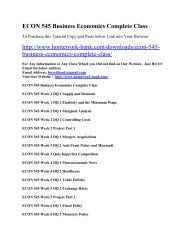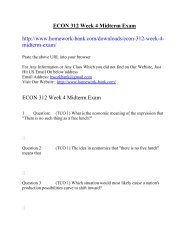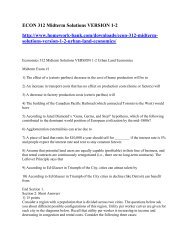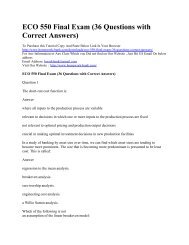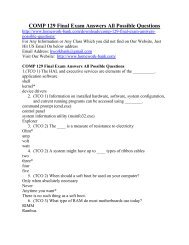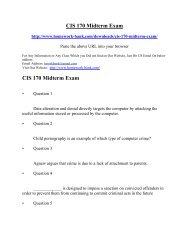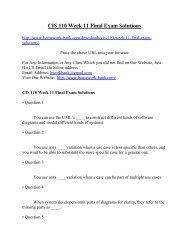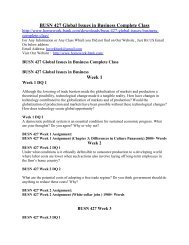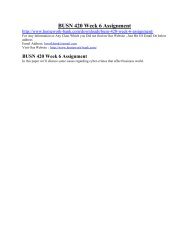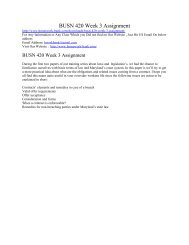o_19i2p1huu1jlcolrik013b5tb12c.pdf
For Any Information or Any Class Which you Did not find on Our Website , Just Hit US Email On below address Email Address: hworkbank@gmail.com Visit Our Website : http://www.homework-bank.com/
For Any Information or Any Class Which you Did not find on Our Website , Just Hit US Email On below address
Email Address: hworkbank@gmail.com
Visit Our Website : http://www.homework-bank.com/
Create successful ePaper yourself
Turn your PDF publications into a flip-book with our unique Google optimized e-Paper software.
BOSP 326 week 8 final Exam(All Questions with Correct Answers)<br />
http://www.homework-bank.com/downloads/bosp-326-week-8-final-examall-questions-correct-answers/<br />
BOSP 326 week 8 final Exam(All Questions with Correct Answers)<br />
1. (TCO 1) Which of the following practices were utilized by most companies to maintain quality levels<br />
until the start of the 1980s?<br />
Team-based initiatives<br />
Process-improvement efforts<br />
Design-quality reviews<br />
Mass inspection<br />
2. (TCO 1) Quality is most difficult to measure and analyze under which of the following definitions?<br />
Judgmental<br />
User-based<br />
Product-based<br />
Value-based<br />
3. (TCO 2) Which of the following systems do not have a role to play in assuring quality in a<br />
manufacturing firm?<br />
Sales<br />
Purchasing<br />
Tool Engineering<br />
None (All answers have a role.)<br />
4. (TCO 2) _____ is a challenge facing many service firms such as Avis, Inc.'s Worldwide Reservation<br />
Center that handles millions of calls and books more than six million reservations in a year.<br />
The high volume of transactions leading to numerous opportunities for error<br />
Service sector decline<br />
The inability to define and measure quality<br />
High labor turnover<br />
5. (TCO 3) In which of the following categories can companies receive a Malcolm Baldrige National<br />
Quality Award?<br />
Small business<br />
Manufacturing<br />
Service<br />
All of the above<br />
6. (TCO 3) ISO 9000:2000 defines a _____-based approach to quality management systems.<br />
customer<br />
statistics<br />
process<br />
product<br />
7. (TCO 4) _____ is a method the Deming philosophy focuses on for improvements in product and<br />
service quality.<br />
100 percent inspection<br />
Reducing variation
Financial analysis<br />
Separating the planning and execution functions of management<br />
8. (TCO 4) The primary reason for Deming's position that slogans should be eliminated is which of the<br />
following?<br />
9. (TCO 5) Measurable performance levels that define the quality of customer contact with an<br />
organization's representatives are known as which of the following?<br />
Customer contact requirements<br />
Quality function deployments<br />
Indexed service standards<br />
Consumer benefits packages<br />
10. (TCO 5) Maintaining a clean, well-lit waiting room in a doctor's office is an example of which<br />
service-quality dimension?<br />
Competence<br />
Courtesy<br />
Communication<br />
Tangibles<br />
11. (TCO 6) The leadership skill of _____ is demonstrated by leaders who encourage employees to<br />
participate in quality-improvement efforts and develop cross-functional teamwork and customer-supplier<br />
partnerships.<br />
visioning<br />
intuition<br />
empowerment<br />
self-understanding<br />
12. (TCO 6) The _____ theory of leadership suggests that the manner in which leaders deal with<br />
subordinates depends on contingent rewards and punishments.<br />
attributional<br />
transactional<br />
substitutes for leadership<br />
emotional intelligence<br />
13. (TCO 7) Employee suggestion systems have been used to identify ways to _____.<br />
improve quality<br />
reduce costs<br />
improve worker safety<br />
All of the above<br />
14. (TCO 7) Under Herzberg's theory of motivation, worker safety would represent a(n) _____ factor and<br />
advancement would represent a(n) _____ factor.<br />
motivational, maintenance<br />
maintenance, motivational<br />
attribute, innovative<br />
innovative, attribute<br />
15. (TCO 8) A group of employees in an office who are fully responsible for all aspects of processing<br />
claims at an insurance company is an example of which of the following team types?<br />
Problem-solving team<br />
Project team
Virtual team<br />
Self-managed team<br />
16. (TCO 8) During the _____ stage of a team's life cycle, team members agree on roles, ground rules,<br />
and acceptable behavior when doing the work of the team.<br />
Forming<br />
Storming<br />
Norming<br />
Performing<br />
17. (TCO 9) Which of the following is not part of a process control system?<br />
Comparison of actual results with the standard<br />
A means of measuring accomplishment<br />
A standard or goal<br />
A backup process<br />
18. (TCO 9) Process management consists of which of the following?<br />
Design, management, and improvement<br />
Design, control, and improvement<br />
Design, control, and standardization<br />
Analysis, control, and improvement<br />
19. (TCO 10) During Final Inspection at a shirt manufacturer, more than 1,500 shirts were found with<br />
incorrect buttons. The manufacturer sold the shirts at 70 percent of the normal price to a retailer who<br />
specializes in factory seconds. The revenue lost by the manufacturer is considered which of the<br />
following?<br />
An internal failure cost<br />
An appraisal cost<br />
An external failure cost<br />
A prevention cost<br />
20. (TCO 10) The additional labor that is used when a machined part is returned to the drilling department<br />
for rework to correct a quality problem is considered which of the following?<br />
A prevention cost<br />
An appraisal cost<br />
An internal failure cost<br />
An external failure cost<br />
21. (TCO 11) Which of the following is NOT a principle of statistical thinking as a philosophy of learning<br />
and action?<br />
All work occurs in a system of interconnected processes.<br />
Variation exists in all processes.<br />
All variation can be traced to human error.<br />
Understanding and reducing variation are keys to success.<br />
22. (TCO 11) Which of the following tools is most useful for viewing the variability of a quality<br />
characteristic?<br />
Affinity diagram<br />
Control chart<br />
Checklist<br />
Fishbone diagram
23. (TCO 12) Everything else remaining constant, when the sample size _____, sampling error decreases.<br />
increases<br />
decreases<br />
stays constant<br />
None of the above<br />
24. (TCO 12) Determine the upper control limit (UCL) and lower control limit (LCL) for an X-Bar chart<br />
if six samples of subgroup size 3 (n=3) were collected, the mean of the sample averages is 4.7, and the<br />
mean of the sample ranges is 0.35. Determine the upper control limit (UCL) and lower control limit<br />
(LCL) for an X-Bar chart.<br />
CHART<br />
UCL = 4.86905, LCL = 4.53095<br />
UCL = 4.90195, LCL = 4.49805<br />
UCL = 4.72250, LCL = 4.14350<br />
UCL = 5.05805, LCL = 4.34195<br />
25. (TCO 12) Determine the upper control limit (UCL) and lower control limit (LCL) for an R-chart if<br />
twenty samples of subgroup size 5 (n=5) were collected for a variable measurement and the mean of the<br />
sample ranges equals 4.4.<br />
UCL = 9.3016, LCL = 0.0000<br />
UCL = 1.4696, LCL = 0.0000<br />
UCL = 11.3256, LCL = 0.0000<br />
UCL = 8.8176, LCL = 0.0000<br />
26. (TCO 13) Which of the following are the phases of the Six Sigma problem solving approach?<br />
Define, Monitor, Analyze, Improve, Confirm<br />
Define, Monitor, Analyze, Invest, Control<br />
Define, Measure, Analyze, Improve, Control<br />
Define, Measure, Analyze, Invest, Control<br />
27. (TCO 14) Current research suggests leadership will have to change from: (Points : 6)<br />
Process to position<br />
Focus throughout the organization to a focus at the top<br />
Power resulting from position to power resulting from knowledge<br />
Feeling and emotional to logical and rational<br />
1. (TCO 3) Answer the following questions concerning ISO 9000:<br />
1. Discuss the basic premise behind ISO 9000.<br />
2. Discuss three of the five objectives of ISO 9000.<br />
3. Discuss the three documents that make up ISO 9000.<br />
<br />
2. (TCO 14) Answer the following questions concerning cultural change and the workforce:<br />
1. Discuss three of the five behaviors that Juran and others suggest are needed to develop quality<br />
cultural change.<br />
2. Discuss ownership at the workforce level and why it is important to the implementation of TQM.<br />
3. Discuss how increased ownership requires increased sharing of information.
3. (TCO 4) Deming's Profound Knowledge consists of four elements. Answer the following three parts<br />
relating to the "variation" element of Deming's Profound Knowledge. Your discussion should relate to<br />
this element of Deming's Profound Knowledge and not variation in general.<br />
1. Explain how a quincunx can be used to explain variation.<br />
2. Why is understanding variation important, and what do we need to do about it?<br />
3. What tools do we need to use to understand variation, and why is using these tools important to<br />
our decision-making process?



